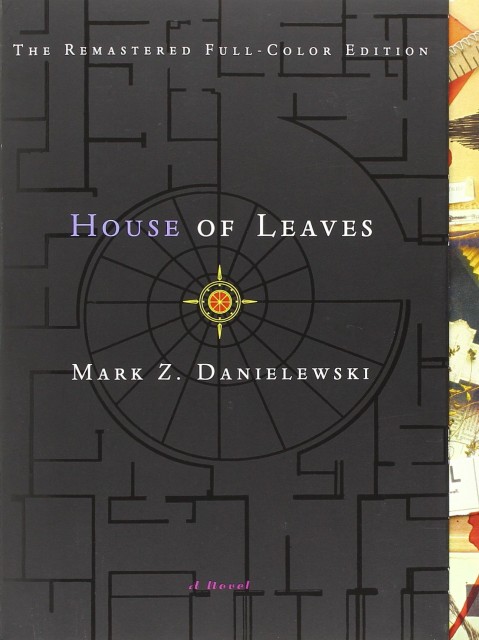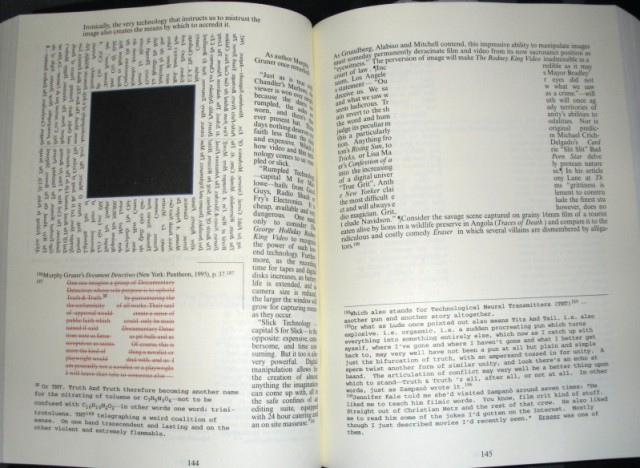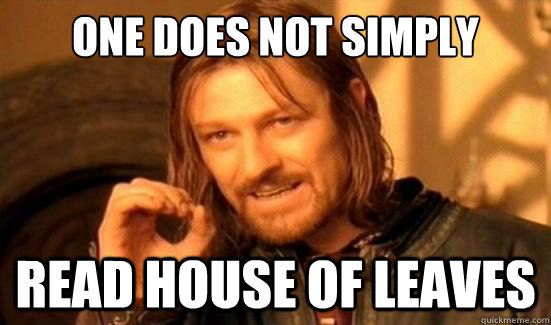 Author: Mark Z. Danielewski
Author: Mark Z. Danielewski
Paperback: 709 pages
Publisher: Pantheon
ISBN-10: 0375703764
ISBN-13: 978-0375703768
Synopsis:
Years ago, when House of Leaves was first being passed around, it was nothing more than a badly bundled heap of paper, parts of which would occasionally surface on the Internet. No one could have anticipated the small but devoted following this terrifying story would soon command. Starting with an odd assortment of marginalized youth — musicians, tattoo artists, programmers, strippers, environmentalists, and adrenaline junkies — the book eventually made its way into the hands of older generations, who not only found themselves in those strangely arranged pages but also discovered a way back into the lives of their estranged children.
Now, for the first time, this astonishing novel is made available in book form, complete with the original colored words, vertical footnotes, and newly added second and third appendices.
The story remains unchanged, focusing on a young family that moves into a small home on Ash Tree Lane where they discover something is terribly wrong: their house is bigger on the inside than it is on the outside.
Of course, neither Pulitzer Prize-winning photojournalist Will Navidson nor his companion Karen Green was prepared to face the consequences of that impossibility, until the day their two little children wandered off and their voices eerily began to return another story — of creature darkness, of an ever-growing abyss behind a closet door, and of that unholy growl which soon enough would tear through their walls and consume all their dreams.
There are 5 star books and there are read-before-you-die, put-it-on-your-bucket-list books. House of Leaves is the latter. It is by no means a new book. It was published in 2000. But it is worth your time and guaranteed suffering if you even remotely claim to be a lover of books.
It has been called one of the most terrifying books of all time. On that I might disagree, but I’m not one to read terrifying books, and while it was most definitely terrifying for me, I have to believe that there are scarier books available, though I don’t plan on seeking them out. Having said this, for several days did the book leave me completely paranoid of being alone in any room of my house in the dark? You betcha.
The story of this book is completely secondary to the experience of this book. When someone mentions that they are starting to read House of Leaves, a typical response is . . .
This book cannot just be read. I am not even exaggerating when I say that I picked up this book and started reading it two years ago. Two years. No it did not take me two years to read it, but I had to make an attempt and walk away, because it is just plain hard.
This book reads like non-fiction with its presentation and footnotes and appendices. This trick of the eye caused me to constantly question the validity of the text even when the text told me the footnotes lead to works that didn’t exist. It took my brain probably 100 pages to reconcile this.
Speaking of pages, the book is wider and taller than most books you read, and with the varying typography and sometimes varying margins, getting to page 100 is actually much harder than it sounds, and by the time you’ve gotten to page 200 you start to get the feeling that the book is expanding, multiplying in pages, especially when you know that the final tally is 709.
While this sounds unnecessarily tedious, it is brilliant. Genius. I joked to SciFi Mafia Editor in Chief Erin while I was reading it that this book might very well be her worst editing nightmare, because in this book the words have a dual purpose. The words on the page tell the story and they take you on the ride. Each time the word house is mentioned it is colored in blue. I don’t even know why but this hit me in my core with a very ominous feeling every time I passed over the word even if it had nothing to do with the house at the core of this story.
And usually when a story presents itself from two different viewpoints it takes its turns in chapters, typically converging in the final moments of the book. This book tells several different stories; the core story of the Navidson family is told through manuscripts written by a man named Zampanò. Those writings are compiled by Johnny Truant who uses (and abuses) the footnotes sections to tell his own story, and those footnotes often go on for a few pages. An unnamed editor notes on all of the above, and Johnny Truant even gets further character depth through included letters in an appendix.
I have no doubt missed or misunderstood large portions of this book because of the way my eyes had to work just to get through the first time (I’m looking at you, Appendix B: The Pelican Poems. What in the world.) I will undoubtedly be reading this book again.
Also let me say that with all the aforementioned paragraphs on the construct of this book, the actual story is fantastic. The construct of the book goes hand in hand with the story. When things happen in the book, it is reflected on the page. When the book gets intense, so do the words on the page, literally.
This book breaks all the rules of structure and uses the page as a canvas. And when you’re in the midst of reading this section above, you can’t help but revel in the genius of it.
This is a book for quiet time. It is pretty hard to read it when you’re distracted. Making the purchase is the first step. Buy this book. It took me two years to dive in, but it is the best book experience of my current existence. I’m looking forward to reading it again.
I give House of Leaves Five Out of Five Stars.
![]()
House of Leaves is available from Amazon! Here’s a link!
[AMAZONPRODUCT=0375703764]


